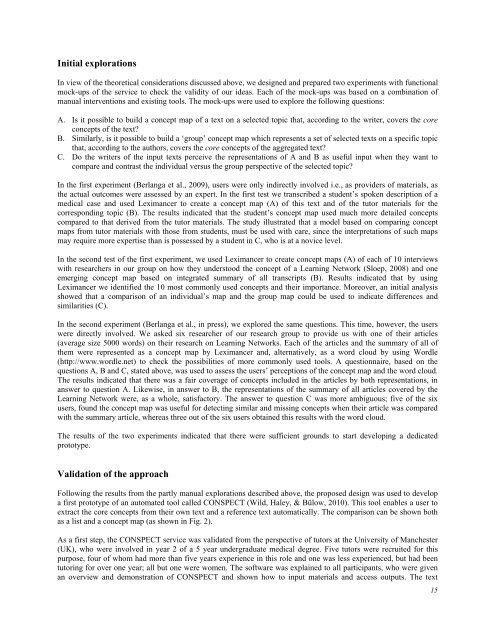October 2011 Volume 14 Number 4 - Educational Technology ...
October 2011 Volume 14 Number 4 - Educational Technology ...
October 2011 Volume 14 Number 4 - Educational Technology ...
Create successful ePaper yourself
Turn your PDF publications into a flip-book with our unique Google optimized e-Paper software.
Initial explorations<br />
In view of the theoretical considerations discussed above, we designed and prepared two experiments with functional<br />
mock-ups of the service to check the validity of our ideas. Each of the mock-ups was based on a combination of<br />
manual interventions and existing tools. The mock-ups were used to explore the following questions:<br />
A. Is it possible to build a concept map of a text on a selected topic that, according to the writer, covers the core<br />
concepts of the text?<br />
B. Similarly, is it possible to build a ‘group’ concept map which represents a set of selected texts on a specific topic<br />
that, according to the authors, covers the core concepts of the aggregated text?<br />
C. Do the writers of the input texts perceive the representations of A and B as useful input when they want to<br />
compare and contrast the individual versus the group perspective of the selected topic?<br />
In the first experiment (Berlanga et al., 2009), users were only indirectly involved i.e., as providers of materials, as<br />
the actual outcomes were assessed by an expert. In the first test we transcribed a student’s spoken description of a<br />
medical case and used Leximancer to create a concept map (A) of this text and of the tutor materials for the<br />
corresponding topic (B). The results indicated that the student’s concept map used much more detailed concepts<br />
compared to that derived from the tutor materials. The study illustrated that a model based on comparing concept<br />
maps from tutor materials with those from students, must be used with care, since the interpretations of such maps<br />
may require more expertise than is possessed by a student in C, who is at a novice level.<br />
In the second test of the first experiment, we used Leximancer to create concept maps (A) of each of 10 interviews<br />
with researchers in our group on how they understood the concept of a Learning Network (Sloep, 2008) and one<br />
emerging concept map based on integrated summary of all transcripts (B). Results indicated that by using<br />
Leximancer we identified the 10 most commonly used concepts and their importance. Moreover, an initial analysis<br />
showed that a comparison of an individual’s map and the group map could be used to indicate differences and<br />
similarities (C).<br />
In the second experiment (Berlanga et al., in press), we explored the same questions. This time, however, the users<br />
were directly involved. We asked six researcher of our research group to provide us with one of their articles<br />
(average size 5000 words) on their research on Learning Networks. Each of the articles and the summary of all of<br />
them were represented as a concept map by Leximancer and, alternatively, as a word cloud by using Wordle<br />
(http://www.wordle.net) to check the possibilities of more commonly used tools. A questionnaire, based on the<br />
questions A, B and C, stated above, was used to assess the users’ perceptions of the concept map and the word cloud.<br />
The results indicated that there was a fair coverage of concepts included in the articles by both representations, in<br />
answer to question A. Likewise, in answer to B, the representations of the summary of all articles covered by the<br />
Learning Network were, as a whole, satisfactory. The answer to question C was more ambiguous; five of the six<br />
users, found the concept map was useful for detecting similar and missing concepts when their article was compared<br />
with the summary article, whereas three out of the six users obtained this results with the word cloud.<br />
The results of the two experiments indicated that there were sufficient grounds to start developing a dedicated<br />
prototype.<br />
Validation of the approach<br />
Following the results from the partly manual explorations described above, the proposed design was used to develop<br />
a first prototype of an automated tool called CONSPECT (Wild, Haley, & Bülow, 2010). This tool enables a user to<br />
extract the core concepts from their own text and a reference text automatically. The comparison can be shown both<br />
as a list and a concept map (as shown in Fig. 2).<br />
As a first step, the CONSPECT service was validated from the perspective of tutors at the University of Manchester<br />
(UK), who were involved in year 2 of a 5 year undergraduate medical degree. Five tutors were recruited for this<br />
purpose, four of whom had more than five years experience in this role and one was less experienced, but had been<br />
tutoring for over one year; all but one were women. The software was explained to all participants, who were given<br />
an overview and demonstration of CONSPECT and shown how to input materials and access outputs. The text<br />
15

















